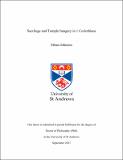Files in this item
Sacrilege and temple imagery in 1 Corinthians
Item metadata
| dc.contributor.advisor | Wright, N. T. (Nicholas Thomas) | |
| dc.contributor.author | Johnson, Ethan | |
| dc.coverage.spatial | 245 p. | en_US |
| dc.date.accessioned | 2022-12-01T16:46:43Z | |
| dc.date.available | 2022-12-01T16:46:43Z | |
| dc.date.issued | 2022-06-16 | |
| dc.identifier.uri | https://hdl.handle.net/10023/26525 | |
| dc.description.abstract | Most scholars read Paul’s application of temple imagery to human beings within a Jewish context, which sometimes means dichotomising Jewish and Greco-Roman data. This leads to approaches that overlook signs of potential resonance between 1 Cor 3:16–17 and 1 Cor 6:19 and discussions of sacrilege in ancient literature. In this thesis, I will contend that Paul’s use of temple imagery in these two passages demonstrates coherence with a pattern common to ancient literature, and that recognizing this coherence clarifies the way the temple should be understood to function in its rhetorical context. I argue that a system of “major metaphysical pollution” lies beneath ancient discussions of sacrilege and I outline the causes, effects, terminology, and means of resolution associated with this system of pollution. I note distinctions between this system and discussions of moral pollution in the OT and consider how one would determine whether Paul’s temple imagery coheres with one system or the other. I also ask whether the logic of major metaphysical pollution is discernible in Josephus and Philo in order to determine whether this system is invoked by other first-century Jews and to understand how these Jews might use it. I then exegete both 1 Cor 3:16–17 and 1 Cor 6:19. In both cases, I attend to the position of the temple in its rhetorical context and compare Paul’s use of the temple with the logic of sacrilege and major metaphysical pollution. I show that the cause, effect, and resolution of threats against the temple in these passages from 1 Corinthians follow the logic of this pollution system. I then offer a new understanding of the temple in its context, based on these conclusions. I suggest that the appeal to the temple in these passages draws on major metaphysical pollution in order to warn the Corinthians to desist problematic behaviours by recasting them as sacrilegious. | en_US |
| dc.language.iso | en | en_US |
| dc.subject | Pauline studies | en_US |
| dc.subject | New Testament | en_US |
| dc.subject | Sacrilege | en_US |
| dc.subject | Greek religion | en_US |
| dc.subject | Temple | en_US |
| dc.title | Sacrilege and temple imagery in 1 Corinthians | en_US |
| dc.type | Thesis | en_US |
| dc.type.qualificationlevel | Doctoral | en_US |
| dc.type.qualificationname | PhD Doctor of Philosophy | en_US |
| dc.publisher.institution | The University of St Andrews | en_US |
| dc.identifier.doi | https://doi.org/10.17630/sta/237 |
This item appears in the following Collection(s)
Items in the St Andrews Research Repository are protected by copyright, with all rights reserved, unless otherwise indicated.

